Steveston Cannery Row
“Somebody just back of you while you are fishing is as bad as someone looking over your shoulder while you write a letter to your girl.” -Ernest Hemingway
The first cannery opened on the waterfront of Steveston Village in 1882, thus establishing the prosperous commercial fishery that would drive the local economy into the next century. Between 1890 and 1900, the Fraser River salmon runs were legendary. The catch one year was described as “an embarrassment of fish.” Thousands of salmon not processed from the previous day’s catch were thrown into the river to make space for the new catch.
By 1890, more than twenty canneries were established along Steveston’s waterfront and record catches of salmon, herring and other species helped make Steveston a boomtown with a seasonal population of 10,000. Each summer large numbers of Chinese, European, First Nations and Japanese fishermen and cannery workers arrived to work at the canneries. That abundant population supported local bawdy houses, gambling and opium dens, and saloons.
Early canneries were labour intensive operations. All work was done by hand on site, including butchering, gutting, filling and cooking the salmon, as well as soldering lids, testing seals, lacquering labels and crating. It took two months to make the 700,000 cans required for the season. By 1912, cannery fish processing lines were automated, reducing the town’s population by half.
In 1889, Henry Bell-Irving organized a shipment of sockeye salmon for Great Britain, which was the first time canned salmon was shipped overseas. It marked Steveston as number one in the salmon industry. Steveston canneries shipped a record setting 16-million pounds of salmon overseas in 1901.
Fishermen
Initially, First Nations and Anglo-Canadians dominated fishing on the Fraser River. Early fishermen used dugout canoes, and 20-foot long flat-bottomed Fraser River skiffs that were prone to capsizing in rough waters. In the late 1880s, round-bottomed Columbia River gillnetters were preferred, which were easier to manoeuvre in rough waters and could carry more weight.
By 1902, gillnetters were fitted with gas engines, and small cabins were built over the bow to protect the engine and provide shelter for the fishermen. Every fishing boat had a fisher and a boat puller. This crew of two, sometimes husband and wife teams, set and pulled 550-foot nets. The only shelter was a crude tent slung across the bow. A 12-hour shift earned $2.25 for a fisher and $1 for a boat puller.
Fishermen were busy year-round preparing for the next season. Net mending and net making were time consuming operations. Originally, all nets were handmade of linen by the fishermen. It took about a month and a half to complete a net that would last up to two years.
The Cannery Office
The Cannery Office is part of the original Britannia Cannery complex. The earliest reference to an office building on the site is a sketch from the 1889 diary of owner Henry Bell-Irving. The building was used as a residence from 1918 until 1942. After World War II it was used as a foreman’s dwelling, and later for storage. Today, it serves as Britannia’s Administration Office.
The construction of the building is unique, as it does not have an internal framing system. The exterior walls were constructed of two thicknesses of wide, vertical planks, without studs or other framing members. During construction, vertical studs used to support the first wall were removed in order to build the second wall. All framing was then taken out and used to build similar structures.
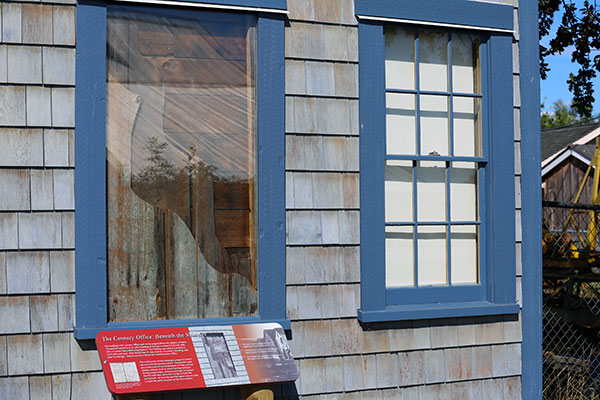
Hell’s Gate Rockslide
In 1913, Canadian Northern Railway blasting operations through Hell’s Gate triggered a rockslide that filled part of the Fraser River with debris. The river became starved for fish when millions of salmon were unable to reach spawning grounds. After several bad fishing seasons and disastrous fires, several canneries merged or closed in 1917. It took more than thirty years to repair the damage and install fish ladders at Hell’s Gate.
Living at Britannia
There were many stilt houses at Britannia, built close together and rising above the mud, tides and storm waters of the river. Today, the stilt houses are positioned over a pond to simulate life over the river, complete with elevated boardwalks connecting each home.
These stilt houses were built in the late 1800s, and were originally located in Steveston Village. They are called “knock-down houses’ or “kit houses’ and were pre-assembled in New Westminster and then barged to Steveston where they became living quarters for employees of a cannery or shipyard. The five stilt houses were moved to their present location in the early 1990s, and the restorations were completed in 2009.
Today, the buildings interpret the stories, lifestyles and living conditions of the many cultures that called Britannia home. At the turn of the century, people from around the world lived and worked at Britannia. At that time, your job and ethnicity defined what kind of house you lived in.
First Nations Bunkhouse
The First Nations Bunkhouse was constructed around 1895 as a dwelling for First Nations workers employed by the Phoenix Cannery. The building is constructed of vertical red cedar board and batten siding, secured with square cut iron nails. The building is similar in form to First Nations longhouses. First Nations cannery workers lived communally, living in the building during the fishing season and returning to their traditional grounds in the off-season. The building was originally located on pilings further north along the main dyke. Some time between 1942 and 1946, it was moved to its present location.
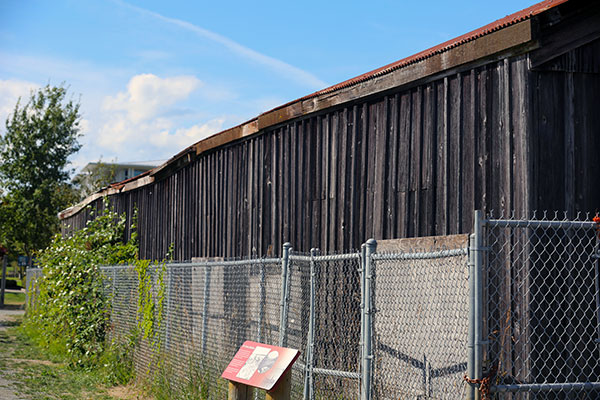
Chinese Bunkhouse
At the turn of the twentieth century, cannery work was labour intensive. Canneries employed thousands of Chinese men, paying them a fraction of the wage of Anglo-Canadian workers. Each cannery hired a Chinese contractor to assemble work crews from nearby Chinatowns and directly from China. The Chinese people who came to work in Steveston were generally residents of the Vancouver, Victoria or New Westminster Chinatowns. The contractor negotiated wages, contract length, provisions and housing.
At the height of the canning season accommodations were bare and cramped, with up to 100 workers sleeping on triple bunk beds in bunkhouses. The Chinese bunkhouse at Britannia was constructed in 1915, as part of the Anglo British Columbia Packing Company’s operation in Knight Inlet, British Columbia. It was relocated to the Britannia site in 1992, and now houses exhibits, programs and special events.
Japanese Duplex
The Japanese Duplex is the last building of its kind on the Steveston waterfront. This building was constructed in the 1890s, one of a cluster of 16 buildings that housed a Japanese immigrant community employed by the Phoenix Cannery. It contains two separate living areas downstairs, with net making space and storage upstairs. After World War II, it was used for fishing gear and net storage. In the 1940s, metal cladding was added over the wood siding. Japanese newspapers used as insulation are still visible inside.
Murakami House
The building was originally on piles over the marsh and could have been built as early as 1885. It was the house of Otokichi and Asayo Murakami and their 10 children from 1929 until their internment in 1942. It was also known as Phoenix House #40 and was among many small residences linked together by wooden boardwalks. A community of two hundred and fifty Japanese families lived on the Steveston waterfront.
Otokichi handcrafted an ofuro, a traditional Japanese bath, for his family. Asayo created a garden beside their home to feed their large family. In 1998, the Murakami family recreated Asayo’s colourful garden in celebration of her one-hundredth birthday.
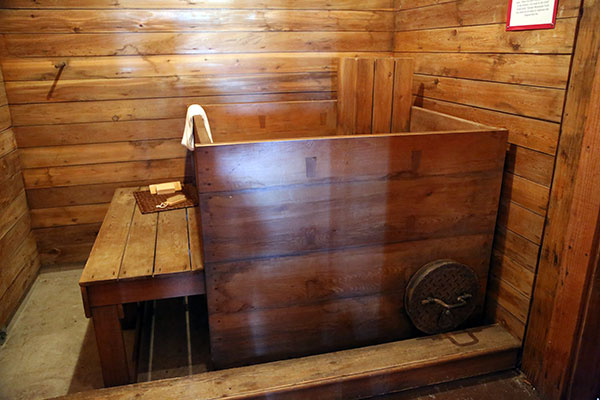
The Murakami residence as seen today in Steveston was reconstructed on a new foundation on its original footprint. The interior was recreated from a sketch drawn by George Murakami, Otokichi and Asayo’s eldest son, and from shared recollections of their other children. Portions of the house were furnished based on their descriptions to reflect life between 1929 and early 1942.
River Water
In the late 1800s, water from the Fraser River was used for drinking, cooking, washing and refuse disposal. Thousands of fish heads, tails and innards from the canneries were dumped into the river daily. Outhouses were built to empty into the river or nearby ditches. This meant disease was a constant threat to people, and epidemics, especially typhoid, occurred regularly until the early 1900s.
Due to the high water table, wells and pumps were not used, and instead, bottled drinking water was shipped in or brought by tram. The City of Richmond joined the Greater Vancouver Water Board in 1930 providing Steveston with a reliable and clean water supply for the first time.
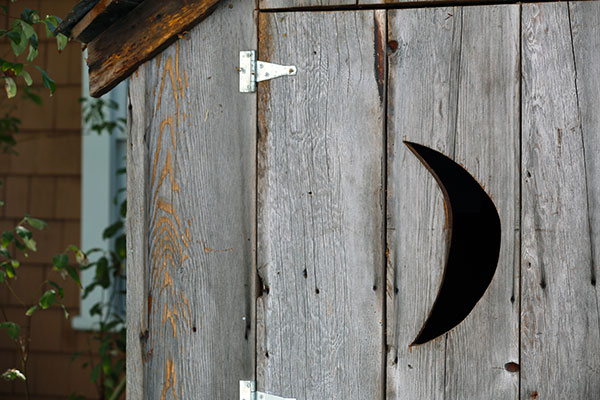
Seine Net Loft
The large net loft was built around 1954 for the Anglo British Columbia Packing Company (ABC Packing Co), who owned the Britannia site from 1892 until 1969. Originally constructed as a seine net loft, it has more recently been used as a storage facility. Net lofts were constructed at cannery sites all along the Steveston waterfront to store and repair fishing nets. Their location on pilings over the water made it easy for fishermen to load and unload their nets from the fishing boats. Their large size and cavernous interiors were designed to facilitate the suspension of large nets for drying.
Shady Island and Storm Protection
Shady Island, across the channel, was once a small sandbar providing minimal protection from storm winds and high waves. In 1955, two rock jetties were constructed on the island to more clearly define the Steveston Channel and provide better protection for the Steveston waterfront. This hastened the process of sand accumulation, resulting in the formation of the island.
The wooden bulkhead south of the boardwalk was built as a breakwater to help keep waves from washing over the boardwalk and into buildings. This is the last place in Richmond where this type of bulkhead construction exists. The boardwalk and bulkhead are important parts of Britannia’s heritage, and were reconstructed in the 1990s. Part of Steveston is located on reclaimed land from the Fraser River. Earth used as infill came from river dredging in the 1950s and 60s.
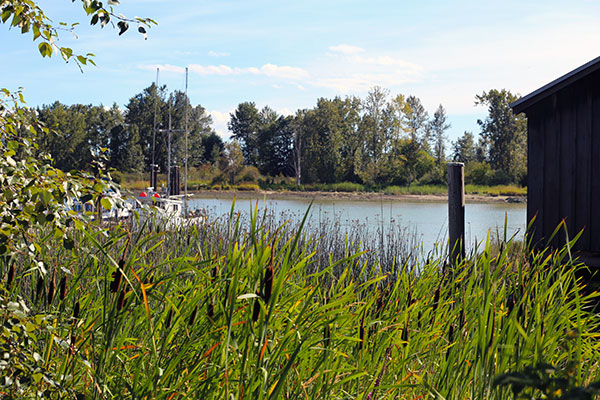
Britannia Shipyard
ABC Packing Co converted the canneries into the Britannia Shipyard in 1917 for the winter housing and repair of its cannery fleet. Managers, foremen, shipwrights, machinists, carpenters, welders, painters, general labourers, bookkeepers, stockmen, and many others were employed to run the new shipyard. ABC owned and operated the shipyard until 1969 when it was sold to the Canadian Fishing Company. In 1979, Britannia Shipyard was sold to BC Packers, and all parts, machinery and equipment were moved to other BC Packers’ properties. Employees were laid off in the spring of 1980.
National Historic Site Designation
The Britannia Shipyard was designated a National Historic Site in 1991 by the National Historic Sites and Monuments Board of Canada. The 3.3-hectare park located along the Steveston Channel of the Fraser River consists of a community of workshops and dwellings that served the shore-based salmon fishery during its boom years from 1890 to 1913. Built over water, the shipyard is part of Steveston’s Cannery Row extending from Garry Point and the Gulf of Georgia Cannery to London Heritage Farm. Many of the buildings on the site were built in 1885.
The property includes the Britannia Shipyard and two boatworks operated by Japanese-Canadians. Labourers and craftsmen of Chinese, European, First Nations and Japanese descent lived in houses on site, and worked in salmon canneries, on the fishing boats, and in the boatworks.
Britannia Shipyards National Historic Site
5180 Westwater Drive
Richmond, British Columbia
(604) 718-8050
britannia@richmond.ca
Summer
May 1 to September 30
Monday to Sunday
10:00 AM to 5:00 PM
Winter
October 1 to April 30
Saturday and Sunday
12:00 PM to 5:00 PM



